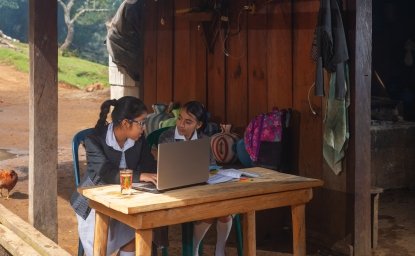After the change of power in the White House, the U.S. and China continue to compete for global supremacy in key technologies of digitalization. The tone and style of the new Biden administration may have changed and in the area of climate policy, joint action even seems possible. In substance, however, relations with Beijing continue to be considered “the biggest geopolitical test of the 21st century,” as the new U.S. Secretary of State Antony Blinken put it in his speech on “A Foreign Policy for the American People” in March in Washington.
For Europe, a renewal of its alliance with Washington seems conceivable again after four years of transatlantic conflict, provided the doors to the Chinese market remain open to European companies and investors. The integration of the U.S. into the EU’s new multi-billion-euros scientific research framework program Horizon Europe would be a strong signal for transatlantic cooperation in research and innovation (R&I).
Time for Tech Cooperation
In the U.S.’s power struggle with its Chinese rival, President Biden is seeking to close ranks with Europe, in contrast to the belligerent tone of the Trump administration. That means “working with our allies to close the gaps in areas like technology and infrastructure, [which] Beijing is exploiting to exert coercive pressure,” Blinken explained in a speech on the renewal of the transatlantic partnership in March in Brussels. The focus is on backlogs in key innovations for digital transformation such as 5G network expansion, semiconductor chips and AI, as well as enabling technologies for energy and transportation.
In an atmosphere of aggressive competition from Asia and the bluster of President Trump’s “America first” policies, the expansion of strategic value chains and the protection of technological sovereignty have become much more important in Europe - prominently visible in the so-called “Important Projects of Common European Interest” in the fields of microelectronics and batteries. With the U.S. returning to its international partners, Europe has the opportunity to build a strategic counterweight to its often unavoidable but at the same time difficult cooperation with China. One important pillar of international cooperation is entering the limelight: research and innovation cooperation.
In a telephone conversation with President Biden at the beginning of March, EU Commission President Ursula von der Leyen outlined her proposal for an “EU-U.S. Trade and Technology Council.” The idea is based on an EU Communiqué from December 2020 for a “New Transatlantic Agenda for Global Change.” In addition to proposals for regulating digital economy platforms and big tech, it also suggests developing a common approach to critical technologies, including AI. In the U.S., a bipartisan plan introduced in the U.S. Senate in April to strengthen American competitiveness vis-à-vis China (Strategic Competition Act) also includes a reconsideration of transatlantic cooperation in the areas of technology, trade and economics. These political initiatives should be accompanied by concrete R&I cooperation at the level of research institutes and scientists.
Utilizing Horizon Europe
With nearly €100 billion in funding over the next seven years, the new research framework program Horizon Europe aims to help the European Union catch up with (public) R&I spending in the United States and China. Hundreds of calls for proposals on topics such as health, digitization, industry, space, climate, energy or mobility will be published in May. The “mission-oriented” approach, inspired by models such as the U.S. Apollo spaceflight program of the 1960s, is intended to herald a paradigm shift in Europe’s research policy, away from small-scale projects and toward solutions for big, global problems.
Close international cooperation with non-European countries is therefore essential. The European Commission distinguishes between “Associated Countries,” such as Norway or Great Britain, which contribute to the Horizon Europe budget and can therefore participate in Horizon Europe projects, and “Third Countries.” With some exceptions, project partners from non-eligible third countries require funding from their national research budgets.
Negotiations with interested partner countries are currently underway. In view of the geo-economic challenges and technological rivals, the EU Commission is re-evaluating the conditions for international R&I cooperation, particularly with regard to establishing a level playing field, reciprocity, security and the preservation of European values. For example, a proposal from Brussels to exclude non-EU countries from the research areas of quantum computing and space travel, which are considered particularly sensitive, is highly controversial. Canada is already cooperating with Brussels and Paris on industrial superclusters, AI and polar research and set up a fund at the beginning of 2020 to provide supplemental financing to European-funded projects. In addition to Canada, countries such as Australia, Japan, New Zealand, Singapore and South Korea are all currently negotiating associated participation in Horizon Europe. For the U.S., this path is proving more difficult.
A Window of Opportunity
On the European side, transatlantic R&I cooperation has been driven primarily at the level of EU Member States, for example, within the framework of bilateral agreements with Germany, Poland or France. The participation of American scientists in Horizon Europe predecessor programs via the third-country solution was rather insignificant and could hardly be improved even with the attempt of a non-binding “twinning” of projects. Reasons given by U.S. partners ranged from inadequate funding, access conditions, and legal hurdles to disadvantageous IP regulations and operational differences in the scientific communities. In February 2020, the Trump administration vociferously rejected a proposal by the EU Commission for privileged program participation as an “associated partner.” Even a special agreement concluded with the Obama administration in 2016, which allowed U.S. scientists to participate in the program without signing a consortium agreement, could not dispel the above concerns.
The strong interest of the new U.S. administration in a transatlantic alliance in its tech competition with China and the EU’s self-confident claim to address global challenges through its Horizon Europe initiative offer both sides a favorable opportunity to renegotiate the terms of their research and innovation cooperation. An association agreement allowing the U.S. to cooperate under Horizon Europe would be a “low hanging fruit,” though not a no-brainer. To some U.S. scientists, Brussels’ tendency to get lost in details and the cacophony of European discourses cause sheer horror. In view of the potential signaling and leverage effects of a close R&I partnership, the EU should nevertheless give the topic space on its “New Transatlantic Agenda for Global Change” and consider a flexible interpretation of the conditions for cooperation. At the same time, the Office of Science and Technology Cooperation in the U.S. State Department should abandon its Trump-era reluctance to cooperate with Brussels.
Authors



Global Europe Program
The Global Europe Program is focused on Europe’s capabilities, and how it engages on critical global issues. We investigate European approaches to critical global issues. We examine Europe’s relations with Russia and Eurasia, China and the Indo-Pacific, the Middle East and Africa. Our initiatives include “Ukraine in Europe”—an examination of what it will take to make Ukraine’s European future a reality. But we also examine the role of NATO, the European Union and the OSCE, Europe’s energy security, transatlantic trade disputes, and challenges to democracy. The Global Europe Program’s staff, scholars-in-residence, and Global Fellows participate in seminars, policy study groups, and international conferences to provide analytical recommendations to policy makers and the media. Read more







